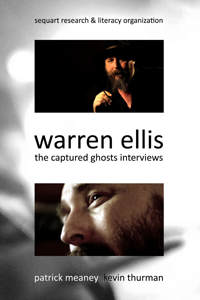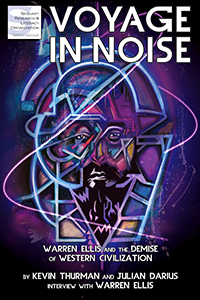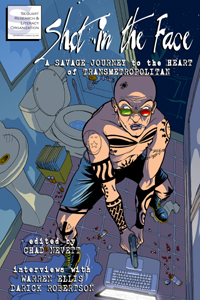Recently, I caught up on Warren Ellis’s Nextwave and Geoff Johns’s recent Green Lantern run through Blackest Night. The two works are polar opposites in terms of approaches to comics; one a continuity-laden, multi-year saga dwelling in the deepest recesses of the DCU, while the other is a done-in-one, light, fun jaunt through a parody version of the Marvel Universe that explicitly rejects continuity.
The generally-held belief would be that Nextwave would be much more likely to draw in a new reader and engage them, while Green Lantern would likely confuse and alienate someone new to comics. The thinking is that Nextwave is going to make more comics fans than Green Lantern would, but I’m not so sure that’s the case, at least when it comes to Big Two super-heroics.
One of the most unique things about super-hero comics that take place in the DC or Marvel Universes is their vast continuity, the fact that each story is the product of thousands of individual issues and choices made by writers many years ago. It’s always exciting to me to see a reference to a story from the past that I’ve read, be it reading about Mon-El in Showcase Presents then seeing him in Geoff Johns’s Superman, or seeing Grant Morrison riff on an Alan Moore Swamp Thing story in Seven Soldiers: Zatanna.
The common complaint is that these stories exclude new readers. I think that can be true for certain writers, but when applied successfully, as I’d argue good writers like Morrison and Johns (most of the time) do, the accumulated history of a comics universe makes for a deeper, more expansive story. There’s a common misconception that you have to understand every element of a story to enjoy it, but that’s not the case at all. One of the beauties of a film like Star Wars is the sense that behind every corner of that universe are other stories, other characters and lives being lived.
But, if the original Star Wars film was instead a comic coming out today, people might complain that we have no idea who Greedo is, or who this Jabba the Hutt that they’re referring to is. The thing is, it doesn’t matter, because we understand who they are through context clues. The best use of continuity in comics is to make it so that someone who isn’t familiar with the stories can understand it from the context, but someone who is familiar gets the added bonus of being able to connect this story to what’s come before.
 Just to clarify, I don’t like stories that require you to read another book to understand it, but I absolutely love the way that Morrison and Johns have recurring elements and characters across all their books. It’s fun to see the Squire show up in a Morrison Batman book and be able to connect her to his JLA: Classified arc or even his original JLA run. Similarly, in the Sinestro Corps War, we see the further development of Superboy Prime, connecting that story to Infinite Crisis and laying the groundwork for Final Crisis: Legion of 3 Worlds.
Just to clarify, I don’t like stories that require you to read another book to understand it, but I absolutely love the way that Morrison and Johns have recurring elements and characters across all their books. It’s fun to see the Squire show up in a Morrison Batman book and be able to connect her to his JLA: Classified arc or even his original JLA run. Similarly, in the Sinestro Corps War, we see the further development of Superboy Prime, connecting that story to Infinite Crisis and laying the groundwork for Final Crisis: Legion of 3 Worlds.
The problem I have with a book like Nextwave, or with the original manifesto of Ultimate Spider-Man as a series of self-contained arcs, is that it gives you no pleasure beyond the moment of reading it. Nextwave doesn’t ask for emotional engagement with the characters, and the characters don’t develop. One of the big pitches of the series is that you can read one arc or all six and still get the same experience. That’s a sentence you could read as a positive (i.e. you only have to buy two issues!), or you could read it as a negative; that reading ten more issues gives you nothing you didn’t get from the first two.
People frequently say that self-contained issues and arcs are the best way to hook new readers. I think they may be the best way to get someone who doesn’t want to read comics to give them a try, but it’s not the way you’re going to make long term fans. It’s possible to be a casual comics fan, to read Maus and Persepolis and not much else, but people who get really into comics usually enjoy the serialized aspect of the medium. The kind of people that become huge fans aren’t going to be the ones who read a done-in-one issue and are satisfied – they’re going to be the ones who read an issue of Green Lantern and want to read years of back issues to catch up and fully understand the story.
The same is true with the Vertigo line of comics. Because comics read so quickly, you need that sustained engagement with a multi-volume series to really make an impression. Something like Preacher may not be as good as Maus, but it’s more likely to get someone hooked on comics and wanting to read more and more.
Particularly with Big Two comics, but even with an ongoing Vertigo series, most major comics fans have a completist kind of personality; a desire to always read more and more, and I think giving someone a series like Green Lantern better activates that desire. When I was a kid, the book that got me into comics was X-Men. I read a few random issues and wanted to know more and more about the world, so I went back and read Claremont’s Essential X-Men Vol. 1, then went on and on until, eventually, I’d read every Claremont book from the ’70s to ’91.
The reason I became hooked was not because of a successful done-in-one story, but rather, it was getting an insight into this expansive universe and wanting to fully understand it.
This isn’t to say that continuity isn’t dangerous. It’s pretty boring to read a comic with a major issue-ending cliffhanger in which the characters are shocked by the sudden reappearance of a character from their past, because the reader might not any idea who that character is. If writers want to bring back an old character, that’s fine, but they shouldn’t rely on a character’s memories to make the story work. The story must explain why the character was important in the first place through actions done in the present.
In Geoff Johns’s case, his work on Sinestro is a great example of showing why an old character is great through the things he’s doing in the present. Johns gets into trickier territory when writing characters like Barry Allen or Hal Jordan, where the idea seems to be that these characters are just intrinsically awesome and the stories exist to reinforce that awesomeness more than show new developments.
Most devoted fans of any medium are ones who always want more. Casual TV viewers will watch a sitcom, while procedural, serious fans watch The Wire and savor every detail, every piece of intricate continuity, and consider continuity and complexity a sign of a more mature work. In TV terms, Nextwave is CSI, and Green Lantern is Buffy.
Now, it’s easy to embrace The Wire as worth your time because it’s socially relevant and something that feels good for you. Is it worth investing the time needed to read 300 issues of Geoff Johns’s comics to fully understand what he’s doing in the DCU? I’d argue that he’s skilled enough to make sure you don’t have to read them all, but also, I think it comes down to what you want out of a story. Do you want to be entertained, laying the issue down knowing the complete story, or do you want the promise of more stories to check out? I read “Sinestro Corps War” and not only wanted to read more Green Lantern, I wanted to catch up on JSA so I could read Legion of 3 Worlds and then Adventure Comics. I love that all those stories tie together, and I love that each seemingly isolated work builds and enhances the other.
And, I’d argue most people who are going to become comics fans like that too. I don’t think you make people fans of comics by hiding them from that which makes the form unique. Nextwave might hook certain people, but I don’t think it has that addictive quality that makes people really need the next issue, the next story. That’s what’s going to get people coming back, and I think people are sometimes scared of embracing what makes comics unique and special. Try to enjoy each individual issue, but also enjoy them as part of a much larger tapestry that’s one of the most complex, ever-evolving pieces of narrative in the contemporary world.
So, ultimately, what work best are stories that use continuity, develop characters, and let the world grow over the course of an ongoing narrative. Stories should use continuity, not be about continuity.






























































I think readers can absorb any degree of continuity when it’s presented in a vital and inventive manner.
My own boring personal story: in 1967 I was just beginning to seriously collect superhero comics, and had seen the Fantastic Four in maybe one or two Human Torch reprints. My first true FF comic was FANTASTIC FOUR ANNUAL #5, which as some may know, puts a lot of the narrative focus on guest stars Black Panther and the Inhumans. I knew none of those characters and barely knew what was going on with the lumpy rock monster, but because it was an exciting, funny story, I could bleep over such concerns as who the Panther was. A villain able to control emotions, a superheroine announcing her pregnancy– how could a kid fail to find such things intriguing, the way Stan and Jack presented them?
Backstory doesn’t have to be a storytelling crutch. The key is knowing how to give just the right amount without drowing the reader in details that don’t tell the main story.
Continuity, along with characters with interesting personalities and little touches of humor is what got me hooked on Marvel comics circa 1970. DC comics just flat out bored me with done in ones and characters with all the personality of cardboard. I was still getting comics hit and miss when I got Amazing Spider-Man #97 in 1971 — I’d missed the two previous issues in this famed 3-part story and I had no idea who Harry Osborne or even Gwen Stacy were at the time, but enough information was provided so I could understand their importance in the life of Peter Parker and the troubles they were all going through. I wanted to know more about these characters. The colorful costumes and fight scenes were fun to my 8 year old self, but even if I wasn’t really aware of it at the time, it was really the meaningful human dramas that rarely had lasting resolutions that Marvel writers came to excel at by the early ’70s that kept me coming back.